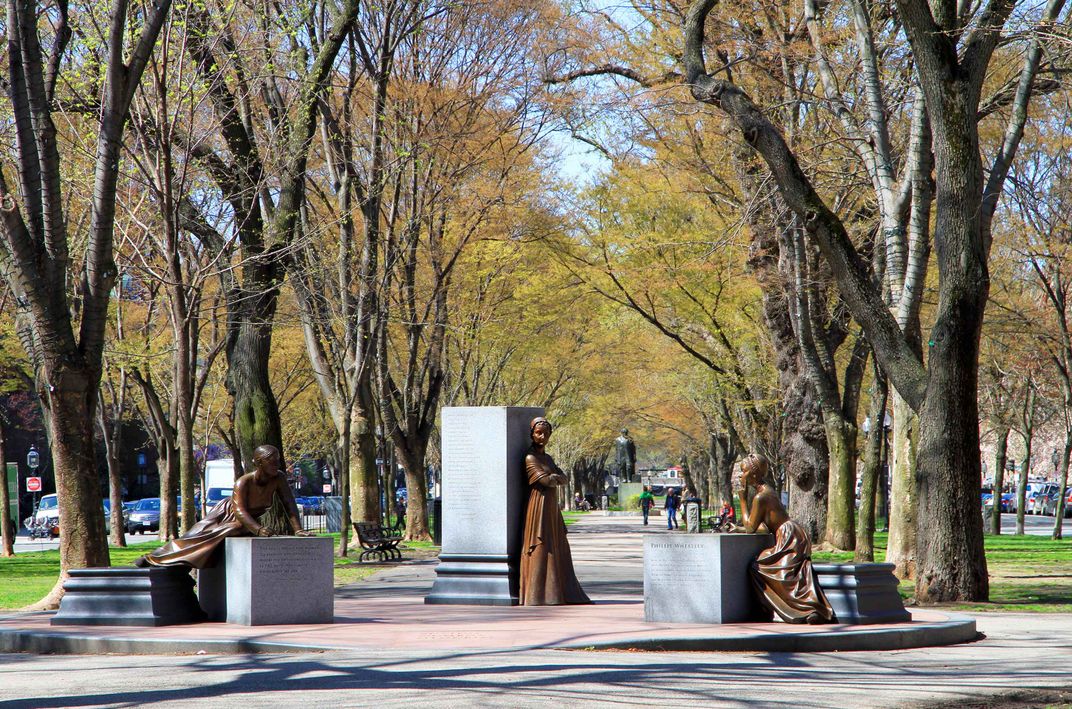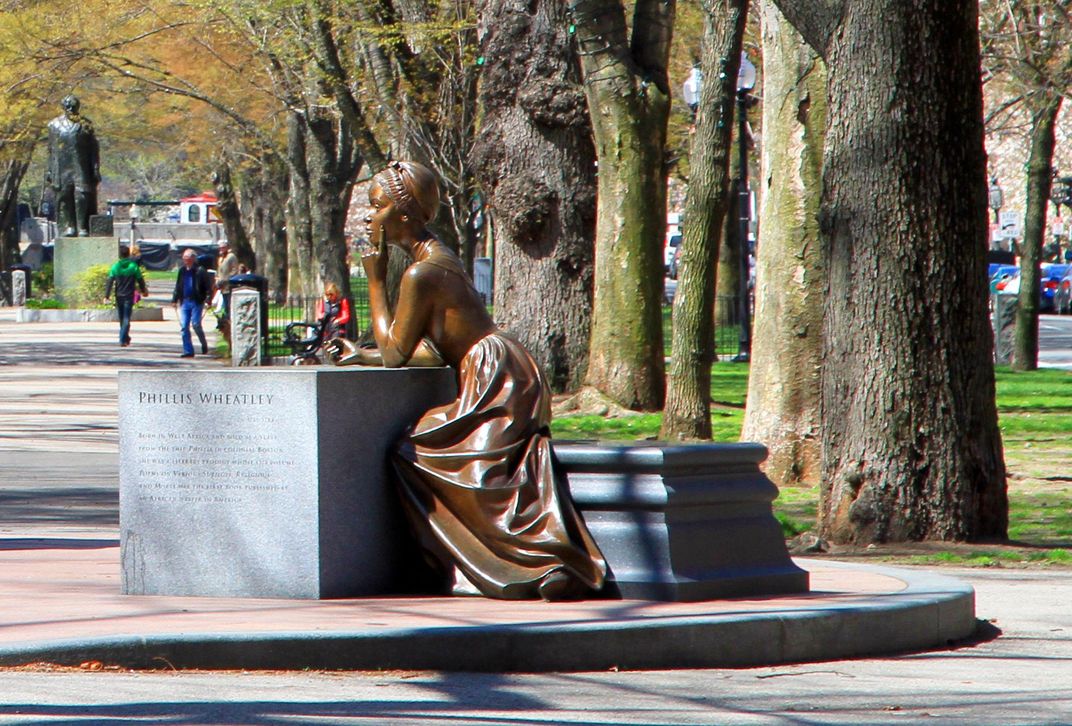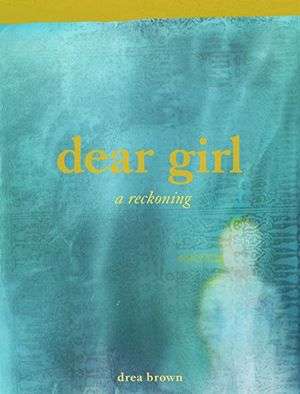The Multiple Truths in the Works of the Enslaved Poet Phillis Wheatley
In this endearing homage, poet-scholar drea brown finds ancestral and personal healing
:focal(853x266:854x267)/https://tf-cmsv2-smithsonianmag-media.s3.amazonaws.com/filer/3a/9a/3a9a5ff6-4e04-4d4b-bb89-a01b08e5014f/npg-s-npg_88_51letter.jpg)
I do not remember how old I was when my grandmother showed me Phillis Wheatley’s poetry. Ten, maybe 11? Young enough that my hands were open to everything she put in them—a crochet needle and thick hot pink yarn, a sewing needle, a gingham apron. Young enough that I obeyed, old enough to roll my eyes in secret when I didn’t want to listen.
My grandmother used Scrabble to sharpen my spelling, fed me Du Bois and folktales about people who could fly. Things I needed to know; things they wouldn’t teach me. And so, she laid Phillis in my lap like fine linen. Something like An Anthology of Fine Negro Poems or The Best Black American Poems. Does it matter?
It was hardbound. It felt important. Langston Hughes was there, Paul Lawrence Dunbar, people she said I needed to know. She turned the thin pages until she was satisfied, and had me read aloud. In my grandmother’s house, recitation was just as important as the reading. Was it a nice day? I do not remember.
The poem was “On Being Brought from Africa to America,” written by a 14-year-old Phillis in the late 18th century. It is one of her most (if not the most) anthologized poems, often accompanied by a bio-paragraph in praise of her genius and publication, despite enslavement and the (unmentioned) complexities of her brief life. Eight lines, sharp end rhymes, it is a verse of passage and piety, of gratitude (but to whom?).
’Twas Mercy brought me from my Pagan land,
Taught my benighted soul to understand
That there’s a God, that there’s a Saviour too:
Once redemption neither sought nor knew.
Some view our sable race with scornful eye,
“Their colour is a diabolic die.”
Remember Christians, Negroes, black as Cain,
May be refin’d and join th’ angelic train.
As a child I stumbled through its meaning; I did not understand why I had to read it or why this enslaved poet I wanted to praise seemed to praise God for her captors.
How was this “Mercy”? How was being brought and bought a saving grace? And what of that July heat in 1761 when the small slaver docked in Boston? Was there a stage set, an auction block? Was it a storefront? Did someone grab hard her frail wrist when she was brought before the gawkers, the could-be purchasers, the soon-to-be-masters John and Susanna Wheatley?
dear girl: a reckoning
Dear Girl: A Reckoning by drea brown revisits the biography of 18th century poet Phillis Wheatley and reimagines her journey through the Middle Passage to Boston. The poems are a gathering of ghosts whose voices shift from slaver to enslaved, from the mouths of the sacred to haunted dreamer. Echoes of loss and fracture each peer into silences and gaps to uncover narratives of restoration.
“Was it a nice day? Does it matter?” These are two seemingly innocuous questions that the playwright and poet June Jordan poses in her essay “The Difficult Miracle of Black Poetry in America, or Something Like a Sonnet for Phillis Wheatley.” In Jordan’s rumination the miracle is Phillis, her persistence on being, and the “intrinsic ardour” through which she names herself a poet. These miracles continue still with Phillis’s figurative children, black women who insist on living in ink. The repetition of Jordan’s inquiry leaves a trail of wonder in its wake—how what appears so simple is not ever quite that. Wonder is what filled me years later, stretched across an orange tweed couch in Oregon and later cross-legged on a porch in Texas. Again I sat, facing the insistent lines of the poet-child—’Twas Mercy brought me from my Pagan land—it was like sucking salt, I pursed my lips, clicked my tongue in refusal. Was it a nice day to be “snatch’d from Afric’s fancy’d happy seat?” Was it a nice day to be bought by the Wheatleys? What matters is I could not accept this “bringing.” I did not trust the poem’s face. Bondage was not liberation. The more I read and reread, the more I was forced to return to the resonating horrors of Middle Passage, to the reality that despite slavery’s attempt at erasure, it’s intention to strip language, personhood and cultural memory—something always survives. There was a gnawing ache going back to that dank “Pagan land.” I was like a child caught in a rough current of verse. And I cried. I tossed in anger like a wild wave. I refused the words’ surface and stared into the ink like ocean, first blue-green, then purple, black, until something else stared back at me. Remember, she said, and I wanted to, I needed to. Because if I could, I could see her.
The thing about “being brought” is that it implies neither here nor there, neither departure nor arrival, Africa or America, but an in between, a crossing from here to there, from free to fettered. It is about being in the middle—of the ocean, of passage, somewhere between life and death. On being on the Atlantic. On being brought by ship, by slave ship. Surely this maritime world swabbed with blood and loss is indeed a “Pagan land.” When my eyes—by which, I also mean my mind, my spirit—adjusted to this, my stomach settled. Such a read felt right. It was then that I could hold Mercy in a new way, as something that remembers what endures, what comes before capture, conversion, censorship, before a crossing that was tumultuous and deadly. And I could see her, a child tossed on the high seas, a child who by all accounts should not have been onboard the Schooner Phillis, because the captain had been told not to bring any women or girls. Regardless, she became a part of that “disappointing cargo,” and once purchased was named for that very vessel. How could she not write of being brought? It was a long day; the sun surrendered to night. This does not matter. What is important is that the girl who became Phillis Wheatley began to come more and more into view. It was the complexity of “being brought”—those words, that action (what comes with it and is left to sink or float)—that brought Phillis Wheatley to me, that brought me to her, and to her poems, her letters, her spirit. All of this brings me closer to the work I am here to do. These relationships are deftly intertwined. A girl can be a poem, a map; all of this I am learning to name.

I find myself reading Phillis’s poems about water and mythology: muses, gods and goddesses, the celestial and ethereal. I read her instructive elegies, how she churns grief into consolation and cream, soft white seraphim, calla lilies for Bostonian elites, but no mention of the daily dying of “our sable race,” those still being brought, those who did not make it alive. Restraints of a conditional fame. Inside each one I envision rows of obsidian stone, a guttural melancholia, quietly shaped into prayer.
I live inside her lines. Take my time walking their halls and opening doors (maybe) I shouldn’t touch. There is so much there and ostensibly not there, but peering closer leads me to all that lives in between. It leads me to Phillis. I sat with her Mercy years ago, and she has not left me since. Phillis feels like kin, and our connection reciprocal, sacred. It is entrenched in passage and memory, in archives of possibility and imagination.
Sometimes she speaks and I listen; she is a storyteller while I scribe. Sometimes we inhabit the same space. When I dream of death-rotting wood, blood-slick and smelling of iron and shit, I see a child’s eyes in the dark. Even when it is day it is dark and the eyes are glassy and shining, with tears of sickness or disbelief. In dreams, sounds echo from the hold, Bantu, Fulani, Yoruba, words unfamiliar when I wake, moans that stay with me through the day. Sometimes I wake covered in sweat that smells like the sea. In those dreams she is mine, a girl with bony hips and no front teeth, a sister by blood or by boat, or she’s a woman on the precipice of freedom, a mother cradling afterbirth.

There is a bird scar on my left hand. I was told as a child I cracked a mirror trying to pull the girl on the other side through. In some dreams my fist is bloody. In others one of us always tugs the other’s arm. There is glass everywhere. Phillis enables me to remember something I should not, and should not forget. Sometimes she is losing, but always she is fighting and survives. On any day, this matters.
At the Boston Women’s Memorial, Phillis Wheatley sits across from Lucy Stone and Abigail Adams. Resting a finger against her temple, frozen and pensive, she stares out into the Back Bay. This morning, my third visit this week, a fresh bouquet rests in the crook of her arm: red and white carnations wrapped in pink tissue paper and plastic. An envelope is tucked into it, and someone has carefully written, “To the African Poetess/From Your Children.” For a moment I think to check if the cowrie I laid in her hand some time before is still there, though that matters less than what is there now. The note brings me joy, because there is something implicitly regal in the handwritten address, something inherently beautiful in the signature. The blooms are bright, and all of it declares she lived, and we exist. Her children. Bringing offerings of gratitude and shells, ribbon and petals and candies.
It is a nice day. Does it matter the sun glints off her cast bronze face, or that light pushes against her still lips? It does. She seems to smile. I wonder what she is thinking, where her bones are buried. At Copp’s Hill or Granary, or near a neighbor’s house somewhere in between? Such loss is bedeviling.
When a stroller is leaned against her tucked legs, when a child beats against her skirt and a dog stops to squat, I feel protective. I watch a woman pick through Phillis’s flowers, turn over the envelope to inspect it, then snap a picture, I stand up. This is a subtle violence, though nothing here is intentionally malicious. It is just a nice day, and people run through parks, children squeal in curiosity, dogs do their business. People pose, and lean against, and walk up and touch. What right do I have to scream, That ain’t yours! Or, Don’t beat her like that, don’t gawk, put that somewhere else, sit and listen awhile. Who am I to dictate how anyone moves through sculptures? Each woman is nearly six feet tall, thick-limbed, cast larger than life. They are entrancing, and it is difficult not to reach out. Public art is made for interaction, the artist wants these women to be accessible. But this one, this one, in all ways already was. Even on nice days people are made into property, this one a gilded-caged prodigy.
This would be easier—the touching, the taking, if there were a place to lay flowers undisturbed. Instead, what I have is a whining heart at a monument that is the closest thing to a place of reverence and memoriam. What I have is something like anger bubbling in my spit, a quaking hand and a praise poem for a girl grown into an unmarked grave. What kin are you that leaves me like this?
Here is what matters. What I feel with Phillis is not all about the body: of the poem, the ship, this statue, her lost bones. It is the condition and connection of the spirit—a feeling that is ancient and deep, a desire that spreads and saturates and leads to new ways of knowing. My relationship with Phillis is composed of a kind of love and disaster that pushes me through and into gaps toward ancestral and personal healing. It feels right to me, even the most gnarled and tenuous spaces. Relationships are complicated. Like a poem by a child that seems to begin in honor of abduction and ends by naming “Negroes, Black as Cain” as divine. In this one I am both protective and protected, taught to mind and master my tongue, listen to what else I am told, to find what I am feeling in my lines and breaks. It teaches me how to move through the murkiness of passage, how to reckon with all that lies in between, to unhinge the contradictions of a nice day. Where shall I dig, I wonder. Where might I lay flowers for the girl/African Poetess/(fore)mama in memoriam.
drea brown is a poet-scholar and assistant professor of literary and cultural studies at Bryant University. Her most recent book is dear girl: a reckoning.
A Note to our Readers
Smithsonian magazine participates in affiliate link advertising programs. If you purchase an item through these links, we receive a commission.
/https://tf-cmsv2-smithsonianmag-media.s3.amazonaws.com/accounts/headshot/db.headshot18.jpg)

/https://tf-cmsv2-smithsonianmag-media.s3.amazonaws.com/accounts/headshot/db.headshot18.jpg)